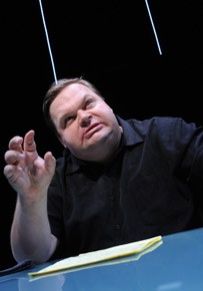Critics To Mike Daisey: Power Down Steve Jobs Stage Show

Mike Daisey hasn't let a little thing like being discredited by a national radio program stop him from reviving his one-man stage show "The Agony and the Ecstasy of Steve Jobs." The now-infamous theater monologist has reworked the purported expose on Apple manufacturing for a three-week run at the Woolly Mammoth Theatre in Washington, D.C.
And it goes without saying that not everyone is happy about the reboot.
The show, which runs through August 5, is attracting its share of criticism within the theater community and journalistic circles alike, and one of its most vocal critics is the reporter who exposed Daisey's fabrications. Rob Schmitz, the China correspondent for American Public Media's "Marketplace," spoke out in an interview with PandoDaily on Tuesday, saying that he can't understand why people are still listening to a performer who "has proven that he has a penchant for lying."
"That's what bothers me the most, when I see that people are still interested in it," Schmitz said. "And maybe they're just interested in it for entertainment value, and that's fine. But it's a little disturbing, because it crosses the line of information and entertainment. It's infotainment."
In Daisey's original production, which he first passed off as a work of nonfiction, the monologist recounted his visits to the Foxconn technology plant in Shenzhen, China, where iPhones and other Apple devices are manufactured. Daisey claimed to witness horrid conditions and assembly-line workers as young as 12 and 13. Schmitz, who lives in Shanghai, heard Daisey's story and tracked down his translator, Cathy, who corroborated some of Daisey's accounts but discounted many others -- including the aforementioned 12-year-old workers. The glaring falsehoods forced NPR's "This American Life" to humbly retract an enormously popular episode in which it excerpted the monologue as a work of nonfiction.
In the PandoDaily interview, Schmitz conceded that Daisey's monologue did raise awareness about working conditions in China. However, having visited Foxconn factories himself, he said that Daisey's demonizing account of Apple manufacturing muddies the more complex issues facing China's economy. Life on an iPad assembly line may be monotonous, he said, but it may also be the lesser of evils for many Chinese laborers. "Their alternative, if they were not at this factory, is that they would be 1,000 to 2,000 miles away, in a rice paddy, or in some other produce paddy, doing the same motions over and over, except they'd be planting rice," he said.
On his blog, Daisey wrote that his decision to remount "Agony and Ecstasy" came from a feeling that he had a "responsibility to tell it right." For the new version, he not only edited out the accounts that were disputed by his translator, but he also gave the narrative a meta-makeover with personalized tidbits on his fall from grace. "Why believe me? I'm a noted fabulist," he reportedly says in the show.
When word of Daisey's fabrications first broke, he initially defended them by saying that he is not a journalist, and he continues on that line of defense in the revival. "In this new version, I try to make it very clear that I am a storyteller," he wrote. "I remind audiences, point blank, that they do not need to believe anything they hear on this stage and urge them to find tools to investigate for themselves beyond the theater."
Some local critics are not buying the hype, however. The Washington Post's Peter Marks described the show as being "stripped of its most powerful ingredient -- Daisey's firsthand accounts of labor abuses inside a Chinese plant that makes Apple products."
Critic Benjamin R. Freed of the website DCist agreed, calling the production an "irreparably damaged monologue."
Daisey, meanwhile, maintains that the show still offers valid commentary on the horrid conditions under which our shiny Apple devices are manufactured. Indeed, those conditions were uncovered by none other than the New York Times for its hard-hitting iEconomy expose, which was first published in January 2012.
By that time, Daisey had already been performing his show for almost a year and a half.
© Copyright IBTimes 2024. All rights reserved.






















